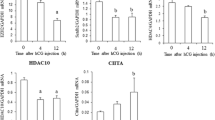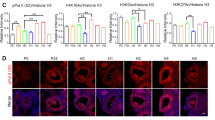Abstract
We investigated the expression of genes and transcription factors associated with steroidogenesis during the luteinization of granulosa cells isolated from bovine small follicles. Granulosa cells produced progesterone when cultivated in a culture medium including serum and attached to the substrate and began to display an elongated or fibroblastic aspect within 24 h of culture. We observed an increase in the number of granulosa cells at the same time. P450arom expression in the cultured granulosa cells had decreased at 24 h compared with 0 h of culture, and afterward was maintained at a low level. This expression was consistent with the decline of E2 concentration in the medium. Expression of StAR and P450scc mRNAs in the cultured granulosa cells was significantly increased at 72 h compared with 0 h of culture. Although the expression of Ad4BP/SF-1 mRNA began to increase during period between 48 and 72 h of culture, protein expression of Ad4BP/SF-1 remained at a constant level throughout the culture period. DAX-1 mRNA expression had decreased at 24 h of culture and remained at a low level. In parallel with this expression, the protein expression of DAX-1 began to decrease between 24 and 48 h of culture and then remained at a low level. Histone H3 acetylation of the StAR promoter region was observed at 72 h of culture period. Our data suggested that the decrease of Dax-1 transcription factor and the increase in histone H3 acetylation may play important roles in progesterone synthesis in luteinizing granulosa cells.





Similar content being viewed by others
References
Channing CP, Ledwitz-Rigby F (1975) Methods fro assessing hormone-mediated differentiation of ovarian cells in culture and in short-term incubations. Methods Enzymol 39:183–230. doi:10.1016/S0076-6879(75)39020-4
Niswender GD (2002) Molecular control of luteal secretion of progesterone. Reproduction 123:333–339. doi:10.1530/rep.0.1230333
Stocco DM (2001) StAR protein and the regulation of steroid hormone biosynthesis. Annu Rev Physiol 63:193–213. doi:10.1146/annurev.physiol.63.1.193
Fortune JE (1986) Bovine theca and granulosa cells interact to promote androgen production. Biol Reprod 35:292–299. doi:10.1095/biolreprod35.2.292
Espey LL, Richards JS (2002) Temporal and spatial patterns of ovarian gene transcription following an ovulatory dose of gonadotropin in the rat. Biol Reprod 67:1662–1670. doi:10.1095/biolreprod.102.005173
Orly J, Stocco DM (1999) The role of the steroidogenic acute regulatory (StAR) protein in female reproductive tissues. Horm Metab Res 31:389–398. doi:10.1055/s-2007-978761
Pescador N, Stocco DM, Murphy DB (1999) Growth factor modulation of steroidogenic acute regulatory protein and luteinization in the pig ovary. Biol Reprod 60:1453–1461. doi:10.1095/biolreprod60.6.1453
Zanaria E, Muscatelli F, Bardoni B, Strom TM, Guioli S, Guo W, Lalli E, Moser C, Walker AP, McCabe ER, Meitinger T, Monaco AP, Sassone-Corsi P, Camerino G (1994) An unusual member of the nuclear hormone receptor superfamily responsible for X-linked adrenal hypoplasia congenita. Nature 372:635–641. doi:10.1038/372635a0
Muscatelli F, Strom TM, Walker AP, Zanaria E, Recan D, Meindl A, Bardoni B, Guioli S, Zehetner G, Rabl W, Schwarz HP, Kaplan JC, Camerino G, Meitinger T, Monaco AP (1994) Mutations in the DAX-1 gene give rise to both X-linked adrenal hypoplasia congenita and hypogonadotropic hypogonadism. Nature 372:672–676. doi:10.1038/372672a0
Ikeda Y, Shen W, Ingraham HA, Parker KL (1994) Developmental expression of mouse steroidogenic factor-1, an essential regulator of the steroid hydroxylases. Mol Endocrinol 8:654–662. doi:10.1210/me.8.5.654
Hatano O, Takayama K, Imai T, Waterman MR, Takakusu A, Omura T, Morohashi K (1994) Sex-dependent expression of a transcription factor, Ad4BP, regulating steroidogenic P-450 genes in the gonads during prenatal and postnatal rat development. Development 120:2787–2797
Shibata H, Kurihara I, Kobayashi S, Yokota K, Suda N, Saito I, Saruta T (2003) Regulation of differential COUP-TF-coregulator interactions in adrenal cortical steroidogenesis. J Steroid Biochem Mol Biol 85:449–456. doi:10.1016/S0960-0760(03)00217-6
Grunstein M (1997) Histone acetylation in chromatin structure and transcription. Nature 389:349–352. doi:10.1038/38664
Kadonaga JT (1998) Eukaryotic transcription: an interlaced network of transcription factors and chromatin-modifying machines. Cell 92:307–313. doi:10.1016/S0092-8674(00)80924-1
Braunstein M, Rose AB, Holmes SG, Allis CD, Broach JR (1993) Transcriptional silencing in yeast is associated with reduced nucleosome acetylation. Genes Dev 7:592–604. doi:10.1101/gad.7.4.592
Orlando V, Strutt H, Paro R (1997) Analysis of chromatin structure by in vivo formaldehyde cross-linking. Methods 11:205–214. doi:10.1006/meth.1996.0407
Rust W, Stedronsky K, Tillmann G, Morley S, Walther N, Ivell R (1998) The role of SF-1/Ad4BP in the control of the bovine gene for the steroidogenic acute regulatory (StAR) protein. J Mol Endocrinol 21:189–200. doi:10.1677/jme.0.0210189
Miyamoto A, Okuda K, Schweigert FJ, Schams D (1992) Effects of basic fibroblast growth factor, transforming growth factor-beta and nerve growth factor on the secretory function of the bovine corpus luteum in vitro. J Endocrinol 135:103–114. doi:10.1677/joe.0.1350103
Acosta TJ, Miyamoto A, Ozawa T, Wijayagunawardane MP, Sato K (1998) Local release of steroid hormones, prostaglandin E2, and endothelin-1 from bovine mature follicles In vitro: effects of luteinizing hormone, endothelin-1, and cytokines. Biol Reprod 59:437–443. doi:10.1095/biolreprod59.2.437
Murphy BD (2000) Model of luteinization. Biol Reprod 63:2–11. doi:10.1095/biolreprod63.1.2
Shimasaki S, Zachow RJ, Li D, Kim H, Iemura S, Ueno N, Sampath K, Chang RJ, Erickson GF (1999) A functional bone morphogenetic protein system in the ovary. Proc Natl Acad Sci USA 96:7282–7287. doi:10.1073/pnas.96.13.7282
Pierre A, Pisselet C, Dupont J, Mandon-Pepin B, Monniaux D, Monget P, Fabre S (2004) Molecular basis of bone morphogenetic protein-4 inhibitory action on progesterone secretion by ovine granulosa cells. J Mol Endocrinol 33:805–817. doi:10.1677/jme.1.01545
Zazopoulos E, Lalli E, Stocco DM, Sassone-Corsi P (1997) DNA binding and transcriptional repression by DAX1 blocks steroidogenesis. Nature 390:311–315. doi:10.1038/36899
Ito M, Yu R, Jameson JL (1997) DAX-1 inhibits SF-1-mediated transactivation via a carboxy-terminal domain that is deleted in adrenal hypoplasia congenital. Mol Cell Biol 17:1476–1483
Suzuki T, Kasahara M, Yoshioka H, Morohashi K, Umesono K (2003) LXXLL-related motifs in Dax-1 have target specificity for the orphan nuclear receptors Ad4BP/SF-1 and LRH-1. Mol Cell Biol 23:238–249. doi:10.1128/MCB.23.1.238-249.2003
Sugawara T, Kiriakidou M, McAllister JM, Kallen CB, Strauss JFIII (1997) Multiple steroidogenic factor 1 binding elements in the human steroidogenic acute regulatory protein gene 5′-flanking region are required for maximal promoter activity and cyclic AMP responsiveness. Biochemistry 36:7249–7255. doi:10.1021/bi9628984
Wooton-Kee CR, Clark BJ (2000) Steroidogenic factor-1 influences protein-deoxyribonucleic acid interactions within the cyclic adenosine 3,5-monophosphate-responsive regions of the murine steroidogenic acute regulatory protein gene. Endocrinology 141:1345–1355. doi:10.1210/en.141.4.1345
Christenson LK, Stouffer R, Strauss JFIII (2001) Quantitative analysis of the hormone-induced hyperacetylation of histone H3 associated with the steroidogenesis acute regulatory protein gene promoter. J Biol Chem 276:27392–27399. doi:10.1074/jbc.M101650200
Acknowledgment
The authors thank Dr. K. Okuda, Okayama University, Japan, for progesterone antibodies. This study was supported by a grant-in-aid for scientific research from the Japan Society for the Promotion of Science (JSPS), Japan. The authors declare that there is no conflict of interest that would prejudice the impartiality of this scientific work.
Author information
Authors and Affiliations
Corresponding author
Rights and permissions
About this article
Cite this article
Shimizu, T., Sudo, N., Yamashita, H. et al. Histone H3 acetylation of StAR and decrease in DAX-1 is involved in the luteinization of bovine granulosa cells during in vitro culture. Mol Cell Biochem 328, 41–47 (2009). https://doi.org/10.1007/s11010-009-0072-y
Received:
Accepted:
Published:
Issue Date:
DOI: https://doi.org/10.1007/s11010-009-0072-y




